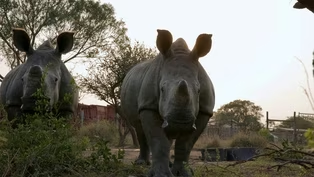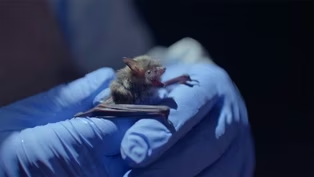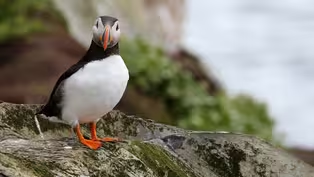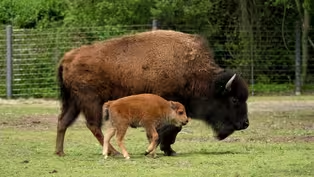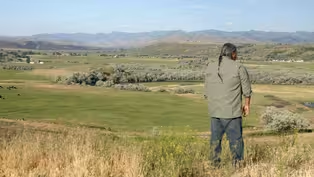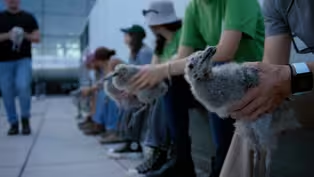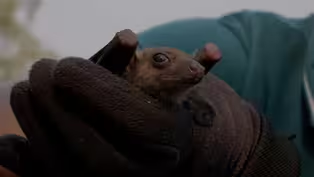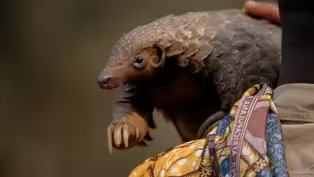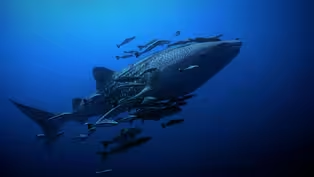
Birds on the Brink | WILD HOPE
Special | 10m 16sVideo has Closed Captions
Is there hope for Hawaii’s endangered honeycreepers?
Hawai’i is home to a broad, beautiful array of bird species found only on its islands — like the stunningly diverse honeycreepers, many on the border of extinction. Now, a local team is removing invasive predators, restoring habitats, and battling mosquito-borne diseases to protect honeycreepers from their latest threat: avian malaria.
Problems playing video? | Closed Captioning Feedback
Problems playing video? | Closed Captioning Feedback
Major support for NATURE is provided by The Arnhold Family in memory of Henry and Clarisse Arnhold, Sue and Edgar Wachenheim III, The Fairweather Foundation, Charles Rosenblum, Kathy Chiao and...

Birds on the Brink | WILD HOPE
Special | 10m 16sVideo has Closed Captions
Hawai’i is home to a broad, beautiful array of bird species found only on its islands — like the stunningly diverse honeycreepers, many on the border of extinction. Now, a local team is removing invasive predators, restoring habitats, and battling mosquito-borne diseases to protect honeycreepers from their latest threat: avian malaria.
Problems playing video? | Closed Captioning Feedback
How to Watch Nature
Nature is available to stream on pbs.org and the free PBS App, available on iPhone, Apple TV, Android TV, Android smartphones, Amazon Fire TV, Amazon Fire Tablet, Roku, Samsung Smart TV, and Vizio.
Buy Now
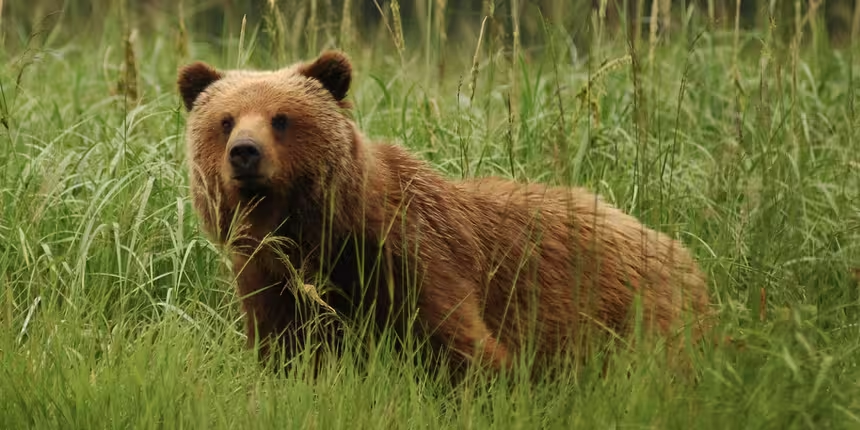
Explore More Ways to Watch
Bring the beauty and wonders of wildlife and natural history into your home with classic NATURE episodes.Providing Support for PBS.org
Learn Moreabout PBS online sponsorshipMore from This Collection
WILD HOPE is a new series of short films that highlights the intrepid changemakers who are restoring our wild places and sparking new hope for the future of our planet.
Video has Closed Captions
How does a densely populated nation like Singapore transform into a lush green oasis? (14m 51s)
Video has Closed Captions
For decades, rhinos have been the face of poaching. (16m 28s)
Video has Closed Captions
As a deadly fungus devastates North America’s bats, scientists are testing new ways to save them. (14m 47s)
Video has Closed Captions
In the Westman Islands, one community has banded together to save lost young puffins. (13m 15s)
Video has Closed Captions
Sixty million American bison once thundered across the prairies of North America. (18m 52s)
Reclaiming Bear River | WILD HOPE
Video has Closed Captions
The Bear River was once a lush area with wetlands, hot springs, and abundant wildlife. (17m 25s)
Building for Birds | WILD HOPE
Video has Closed Captions
Millions of migrating birds pass through our yards, but glass windows pose a deadly threat. (16m 3s)
Mission Impossible | WILD HOPE
Video has Closed Captions
Meet the genius behind the plant-based Impossible Burger. (39m 41s)
Pangolin Protectors | WILD HOPE
Video has Closed Captions
Due to the demand for their scales, pangolins are the most trafficked animal in the world. (12m 24s)
Way of the Elephants | WILD HOPE
Video has Closed Captions
Elephant migration corridors in India are a necessary thoroughfare for one of the largest animals. (15m 11s)
Whale Shark Homecoming | WILD HOPE
Video has Closed Captions
A renowned spiritual leader is inspiring fishermen to become guardians of the world’s biggest fish. (16m 49s)
Providing Support for PBS.org
Learn Moreabout PBS online sponsorship♪ CHRISTA: There were once over 50 species of honeycreepers only found in Hawai'i.
They were seed dispersers, pollinators, predators of many of our native invertebrates.
We now only have 17 species.
If we lose honeycreepers, we lose the balance of our Hawai'ian ecosystems.
NARRATOR: With two thirds of Hawai'i's native honeycreepers already ex.. scientists are taking extraordinary steps to save the few that are left.
♪ CHRISTA: People from all over the world have come together in order to save our species.
But we need to act now.
♪ (birds chirping) ♪ (birds chirping) ♪ I was so inspired when I first came to Hawai'i to work on Hawai'ian honeycreepers.
NARRATOR: 11 years ago, Christa Seidl studied honeycreepers as an intern with the Maui Forest Bird Recovery Project.
When she left for her PhD in disease ecology, she knew she'd return.
CHRISTA: I thought one day I'll come back and I'm gonna be a coordinator for that project.
Here I am.
(laughs) (birds chirping) ♪ NARRATOR: Like Darwin's finches in the Galápagos, honeycreepers are a famed example of how one species can multiply into many.
(birds chirping) ♪ Six to seven million years ago, a single rosefinch species arrived on the Hawai'ian Islands, likely as a flock blown in from Asia by a storm.
♪ Over several million years, and as new islands formed, honeycreepers spread across the archipelago.
They evolved into many different species with unique colorations, beak shapes, and foraging patterns.
These adaptations allow them to take advantage of open habitats.
♪ But the same isolation that allows island species to diversify, also leaves them vulnerable to threats from afar.
♪ The first wave of extinctions began after Polynesians arrived around a thousand years ago.
♪ The rats, pigs and dogs they brought with them started the decline.
(pig snorts) CHRISTA: It accelerated with the arrival of Europeans who brought many more invasive animals with them.
NARRATOR: The honeycreepers had evolved no defenses against these predators, ♪ and when mongooses were later introduced to keep the rats in check, they also began eating the birds, eggs and nestlings.
♪ Invasive plants took their toll too, outcompeting the native species that the honey- creepers depended on.
And then there was human development, which continually encroached on the birds' habitat.
It was a devastating mix of threats.
Today, some of the remaining species have fewer than 200 individuals left.
CHRISTA: We felt like each one of us would eventually come to know a bird that went extinct.
♪ NARRATOR: Unwilling to simply accept such a loss, Christa and her colleagues across Hawai'i went to work.
LAURA N.: So this one's active and we can move on to the next trap.
NARRATOR: They began battling the invasive predators ♪ and restoring native trees to the forests.
♪ LAURA B.: We planted nearly a quarter of a million trees over 16 different native plant species.
♪ NARRATOR: In spots, their efforts seem to be working.
here in Nakula Natural Area Reserve on Maui, the two most abundant honeycreeper species, the 'apapane and the Hawai'i 'amakihi, were flourishing.
CHRISTA: The forest grew back so well that by 2019, we thought it was ready to have one of our rarest species of birds, the kiwikiu, reintroduced to it.
There are less than 150 individuals.
We wanted to reintroduce them to Nakula because we know from the fossil record they once occurred all across Maui.
♪ NARRATOR: What they didn't know was that the forest also hid a devastating disease.
♪ LAURA B.: It was exciting at first because we had released these birds into this area that we had worked so hard to restore.
(bird wings flapping) (birds chirping) But unfortunately, in less than a month, the birds started dying ♪ and we found out that it was from avian malaria.
NARRATOR: Avian malaria is a parasite carried by mosquitoes.
It's been around for millions of years, but only reached Hawai'i in the mid-20th century.
♪ With such low numbers and no natural resistance to the disease, the reintroduced kiwikiu's quickly succumbed.
♪ The deaths were a dire wake-up call.
Avian malaria had become the biggest threat to the honeycreeper populations.
♪ CHRISTA: Avian malaria kills our honeycreepers very quickly, often within a matter of weeks, so they don't have enough time to reproduce and create the next generation.
♪ NARRATOR: Since mosquitoes are the primary vector for the spread of avian malaria, preventing the disease should start with them.
♪ But the clock is ticking.
Rising temperatures are allowing the mosquitoes to move higher up the mountain slopes and into new bird habitats.
♪ Unless that spread can be stopped, the remaining species of honeycreepers will have little chance of survival.
♪ Thinking creatively, the team zeroed in on an approach previously used to prevent mosquito-borne diseases in humans.
(bird wings flapping) (buzzing) CHRISTA: So in order to address the issue of avian malaria, we really need to suppress the mosquito populations that will transmit it onto our native birds by using a control technique that takes advantage of a unique biological interaction.
NARRATOR: Most mosquitoes that carry avian malaria naturally have a bacterium called wolbachia in their gut.
But when a female mates with a male that has a different strain of wolbachia, the eggs from that union simply won't hatch.
CHRISTA: We're taking advantage of this interaction to release male mosquitoes with a bacteria type that does not occur here in Hawai'i.
NARRATOR: By bringing in incompatible males, which do not bite and cannot spread disease, they're effectively introducing birth control for the Hawai'ian mosquito population.
♪ This technique has been successfully implemented in more than 12 countries to reduce mosquito populations and the spread of disease.
♪ CHRISTA: Because we've seen such success in using this technology to reduce human diseases, we're building on all of that knowledge and experience used all around the world to inform the control that we're going to use here in Hawai'i.
Okay, we good to go?
MAN: Yeah.
CHRISTA: Awesome.
♪ We're at the precipice of having a tool to address avian disease.
All the work we're doing has really invigorated us and given us a type of hope that we haven't had in decades.
♪ NARRATOR: Time will tell, but if the tool works, it could be the difference between survival and extinction for Hawai'i's remarkable honeycreepers.
(birds calling) ♪ ♪ ♪ ♪

- Science and Nature

Explore scientific discoveries on television's most acclaimed science documentary series.













Support for PBS provided by:
Major support for NATURE is provided by The Arnhold Family in memory of Henry and Clarisse Arnhold, Sue and Edgar Wachenheim III, The Fairweather Foundation, Charles Rosenblum, Kathy Chiao and...

